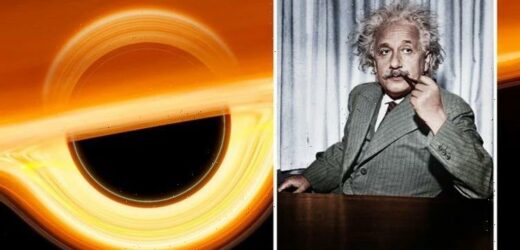Brian Cox discusses the 'disturbing' nature of black holes
We use your sign-up to provide content in ways you’ve consented to and to improve our understanding of you. This may include adverts from us and 3rd parties based on our understanding. You can unsubscribe at any time. More info
Although proven in action time and time again, Albert Einstein’s theory of general relativity is not the foolproof model of gravity it was once thought to be. Relativity works like a charm when scientists try to explain how the universe works at large, exposing gravity as a curvature of space and time and not an invisible force between two bodies, as Isaac Newton proposed. But the theory, which was published in 1915, begins to fall apart when scientists start to probe the universe on the smallest possible scale – the subatomic quantum realm.
It is widely accepted today that general relativity and quantum mechanics do not mesh well and scientists have been desperate to figure out why.
In the world of relativity, events are linear and consequential and deterministic.
In the subatomic world of quantum mechanics, events are probabilistic and happen in leaps with no definite outcomes.
One of the problems Einstein faced in his lifetime, was struggling to define energy in a way that combined the laws of energy conservation and covariance, where the laws of physics appear to be identical for all observers.


A team of researchers at the Yukawa Institute for Theoretical Physics at Kyoto University has attempted to solve this conundrum by incorporating the concept of entropy into the definition of energy.
According to team member Shuichi Yokoyama, efforts to reconcile relativity with quantum mechanics have led to a lot of head-scratching over the years.
But the expert now claims “the solution is shockingly intuitive”.
Einstein’s field equations describe how matter and energy mould the fabric of the universe, spacetime, and how the structure of spacetime consequently moves matter and energy.
Black hole appears to eat neutron stars ‘like Pac-Man’
But the equations are notoriously hard to solve, according to the Kyoto researchers, due to a particular “troublesome factor” that describes mass and energy – the behaviour of a charge associated with an energy-momentum tensor.
The Japanese team has observed that the conservation of charge resembles entropy, a property that is commonly associated with a state of disorder, randomness and uncertainty.
However, the researchers said conserved entropy defies the standard definition, which is described as a measure of the various ways a system can be arranged.
The conserved quantity also contradicts a basic principle known as Noether’s theorem, in which any conserved quantity appears because of some symmetry in the system.


Professor Shinya Aoki said he was surprised to see scientists have not applied the new definition of energy-momentum tensor.
The theoretical physicist added he was “also intrigued that in general curved spacetime, a conserved quantity can be defined even without symmetry”.
The team has since applied this novel approach to try and explain various cosmic phenomena, such as the expansion of the universe and black holes.
The calculations appear to respond well to our present understanding of entropy in Schwarzschild black hole – static black holes without an electric charge or angular momentum.
But the equations also show that entropy density concentrates at the singularity at the dead centre of a black hole.
A black hole singularity marks a point of infinite compression where all concepts of time and space break down.
The Japanese researchers are hopeful their findings will inspire new discussion about the nature of gravity but also the basic principles of physics.
Source: Read Full Article


